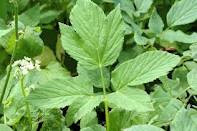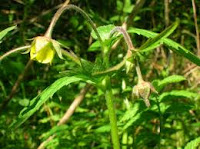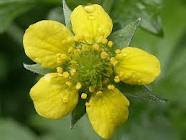Ground elder is the modern name for goutweed or Herb Gerard and as its name suggests it was a specific remedy for gout and sciatica, used as such at least since the Middle Ages in Europe . It gets the name ground elder from the resemblance of the flowers to those of the elder tree (Sambucus nigra). It was used as a green vegetable in earlier times, and was used by monks and bishops to counteract the rich food they so often ate.
It is a member of the Umbelliferaceae or Apiaceae family which includes fennel, dill, sweet Cicely, cow parsley, lovage, carrots, caraway, anise, lesser and greater burnet saxifrage, water fennel or water dropwort, Alexanders and Thapsia. It can grow to heights of two feet and takes over ground very quickly.
Its genus name comes from the Greek aigos meaning goat and podi meaning foot, perhaps because some thought the leaf looked like a goat’s foot; podagra was Latin for gout.
 It was described by Tabernaemontanus a European herbalist in 1687 as a “despised, unlovely weed” and the English herbalist, John Gerard has this to say about it under the name Herb Gerard (it was named after St. Gerard to whom gout sufferers prayed for deliverance from the ailment):-
It was described by Tabernaemontanus a European herbalist in 1687 as a “despised, unlovely weed” and the English herbalist, John Gerard has this to say about it under the name Herb Gerard (it was named after St. Gerard to whom gout sufferers prayed for deliverance from the ailment):-“Herbe Gerard groweth of itself in gardens without setting or sowing and is so fruitful in its increase that when it hath once taken roote, it will hardly be gotten out againe, spoiling and getting every yeare more ground, to the annoying of better herbe.”
However he also sees its virtues and points out:-
“with his roots stamped and laid upon members that are troubled or vexed with gout, swageth the paine, and taketh away the swelling and inflammation thereof, which occasioned the Germans to give it the name of Podagraria, because of his virtues in curing the gout.”
 My father absolutely detested this weed and waged war on it every spring, but even if a tiny part of the rhizome (creeping root) is left in the soil it can regenerate, causing it to be the bane of many gardeners. He didn’t have gout and wasn’t fond of green vegetables, and certainly wouldn’t have considered eating this plant. However the young leaves can be added to a spring salad or cooked and served as a vegetable, as spinach is. You should avoid eating it after it flowers (May-June in
My father absolutely detested this weed and waged war on it every spring, but even if a tiny part of the rhizome (creeping root) is left in the soil it can regenerate, causing it to be the bane of many gardeners. He didn’t have gout and wasn’t fond of green vegetables, and certainly wouldn’t have considered eating this plant. However the young leaves can be added to a spring salad or cooked and served as a vegetable, as spinach is. You should avoid eating it after it flowers (May-June in The roots and leaves can be boiled together and then placed on parts that have sciatic and rheumatic pains and the poultice, changed every so often, as the leaves cool is said to be very effective. The roots and leaves are taken internally as a diuretic and are also used for their sedative effect.
“Government and virtues. Saturn rules it. Neither is it to be supposed Gout-wort hath its name for nothing but upon experiment to heal the gout and sciatica; as also joint-aches, and other cold griefs. The very bearing of it about one eases the pains of the gout, and defends him that bears it from the disease.”
Modern clinical trials have shown that this weed has antibacterial properties, so even “unlovely” weeds have their medicinal purposes.

























